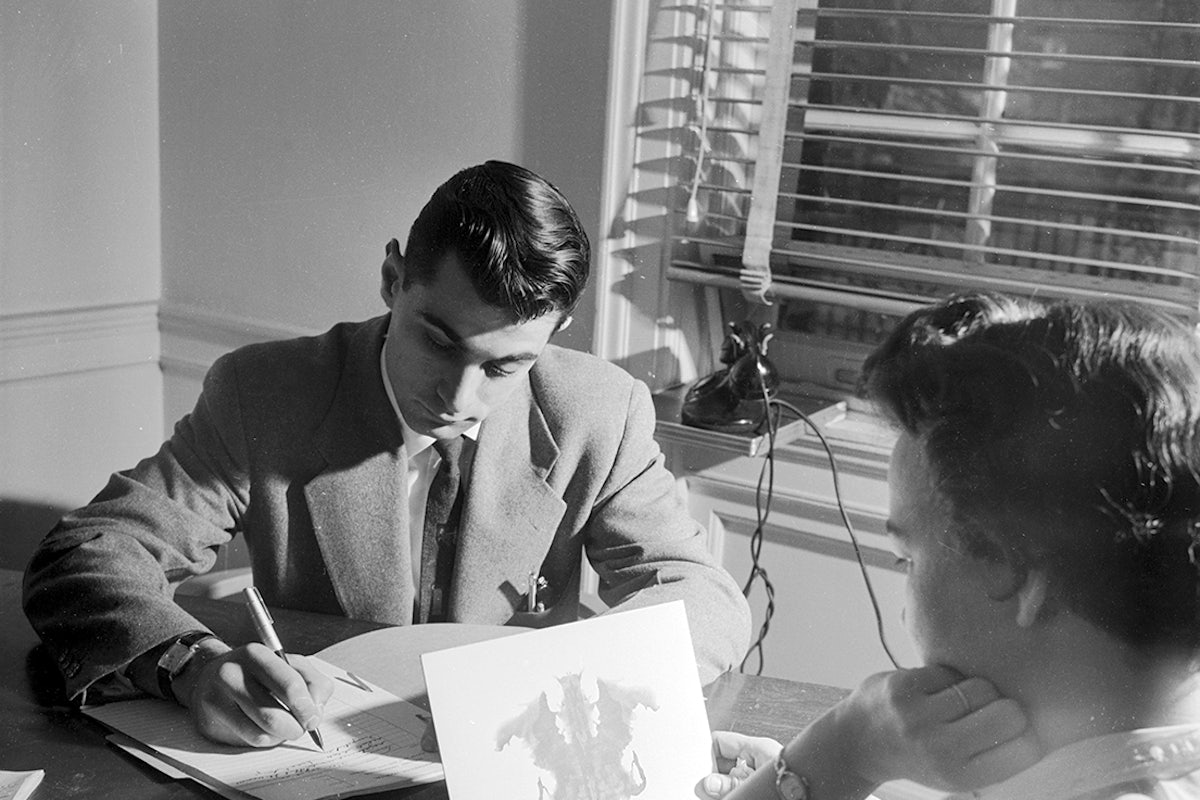via AbeBooks.com by Richard Davies

Albert Einstein’s toy building blocks
Albert Einstein’s much-loved childhood building blocks have been listed for sale on AbeBooks.com.
Housed in two wooden boxes, the set features approximately 160 pieces with some chipped from use. Did these humble toy building blocks nurture the imagination of the boy who would become the world’s greatest physicist? It’s inspiring to think that these simple blocks were indeed the starting point for Einstein.
Continue reading
=============================
The Eye of the Beholder
How Rorschach’s inkblots turned personality testing into an art.
via Arts & Letters Daily: Merve Emry in New Republic

Just after April Fools’ Day in 1922, Hermann Rorschach, a psychologist who used a collection of symmetrical inkblots to treat patients with manic depression and schizophrenia, died of appendicitis in Herisau, Switzerland, at the age of 37. Had he lived, he would have been 40 when his inkblots made landfall in the United States in 1925; 55 when they emerged as a helpful tool for profiling college applicants; 62 when the Pentagon used them to fashion a line of tropical shorts for World War II veterans; and 99 when Andy Warhol poured paint onto a canvas in 1984, folded it in half, and opened it to reveal his first inkblot-inspired painting. Rorschach would have been 121 – unlikely, but not impossible – when Gnarls Barkley released his 2006 music video for “Crazy,” which featured a series of liquefied inkblots that morphed into threatening or reassuring shapes, depending on one’s perspective. And he most certainly would have been dead by 2016, when the film Arrival imagined a world in which aliens could communicate with humans by means of a visual language written in a mysterious, inky pattern.
Continue reading
=============================
Chart of every Nokia dumbphone from 1982-2006
via Boing Boing by Andrea James
Prepare to take a technological trip down memory lane with this enormous comprehensive chart of every Nokia dumbphone model starting 35 years ago. Extendable antennas, clamshells, you name it.
Continue reading
=============================
Iron Age Potters Carefully Recorded Earth’s Magnetic Field – By Accident
via 3 Quarks Daily: Rae Ellen Bichell at NPR

About 3,000 years ago, a potter near Jerusalem made a big jar. It was meant to hold olive oil or wine or something else valuable enough to send to the king as a tax payment. The jar’s handles were stamped with a royal seal, and the pot went into the kiln.
Continue reading
=============================
Dance of Steel
via Arts & Letters Daily: Simon Morrison in the Paris Review
In Soviet Russia, getting a ballet off the ground was no mean feat, as Sergei Prokofiev learned the hard way.

LÉONIDE MASSINE WIELDS A LARGE HAMMER OVER THE HEAD OF ALEXANDRA DANILOVA DURING A PRODUCTION OF PROKOFIEV’S LE PAS D’ACIER IN LONDON.
In Russia, during the Soviet era, government control made the challenge of getting a ballet onto the stage no less onerous than being admitted into the ballet schools of Moscow or Leningrad. The daunting auditions of Soviet legend – teachers scrutinizing preadolescents for the slightest physical imperfection – found an ideological parallel in the required inspections by censorship boards at the Bolshoi and the Mariinsky-Kirov theaters. First, the subject of a prospective ballet was adjudicated in terms of its fulfillment of the demands for people-mindedness; the music and the dance would be likewise assessed. There would follow a provisional closed-door run-through to decide if the completed ballet could be presented to the public, after which it would either be scrapped or sent back to the creative workshop for repairs. Dress rehearsals were subsequently assessed by administrators, cognoscenti, politicians, representatives from agricultural and industrial unions, and relatives of the performers. Even then, after all of the technical kinks had been worked out, an ideological defect could lead to the sudden collapse of the entire project.
Continue reading
=============================
Robotic drone bee pollinates flowers
via Boing Boing by David Pescovitz

Japanese researchers demonstrated how a tiny remote-controlled drone could help bees pollinate flowers in areas where bees populations have been reduced due to pesticides, climate change, and other factors. Eijiro Myako and his colleagues at the Japan’s National Institute of Advanced Industrial Science and Technology hope that eventually robotic bees could handle their share of the work autonomously.
Continue reading
=============================
Was Chaucer really a “writer”?
via OUP Blog by Christopher Cannon

We know more about Geoffrey Chaucer’s life than we do about most medieval writers. Despite this, it’s a truism of Chaucer biography that the records that survive never once describe him as a poet. Less often noticed, however, are the two radically different views of Chaucer as an author we find in roughly contemporaneous portraiture, although the portraits in which we find them are themselves well known.
Continue reading
=============================
Jerusalem Syndrome at the Met
An exhibition on the diverse multiculturalism of medieval Jerusalem has been ecstatically received. There’s just one problem: the vision of history it promotes is a myth.
via Arts & Letters Daily: Edward Rothstein in Mosaic

From an illustration in a Syriac Christian lectionary. 1220, tempera, ink, and gold on paper. Metropolitan Museum of Art/British Library.“Severe, Jerusalem-generated mental problems.” Such, as characterized by the British Journal of Psychiatry, is the pathological derangement known as Jerusalem Syndrome. The madness is generally attributed to the city’s intoxicating spiritual powers, recognized over the centuries to inspire wild prophecies, orotund pronouncements, and utopian fantasies sometimes accompanied by predictions of imminent apocalypse.Continue reading
=============================Bosch and Bruegel review – more gripping than a thriller
via the Guardian by Alexandra Harris

Everyday symbolism … detail from Pieter Bruegel the Elder’s The Fight Between Carnival and Lent (1559). Photograph: Alamy
Hieronymus Bosch and Pieter Bruegel the Elder work like antagonistic muscles in the imagination, pulling with and against each other. Bosch is a painter of medieval hellfire whose fantastical creations exceed our nightmares. Bruegel, most memorably and wonderfully, shows us a recognisable world where children lick bowls clean, bagpipers draw breath and harvesters stretch out in the sun. Turning from metaphysics and from myth, he attends to the ploughman who labours his way across a field while Icarus falls into the sea far below. Bosch’s pale figures belong to the international gothic; Bruegel’s weighty peasants dance vigorously into modern times.
Continue reading
=============================
Watch: David Bowie's first TV appearance at age 17 was a delightful prank
via Boing Boing by David Pescovitz
In November 1964, 17-year-old David Bowie (then Jones) appeared on BBC’s “Tonight” to talk about his new Society for the Prevention of Cruelty to Long-Haired Men, a PR stunt cooked up by his dad.
Continue reading
No comments:
Post a Comment